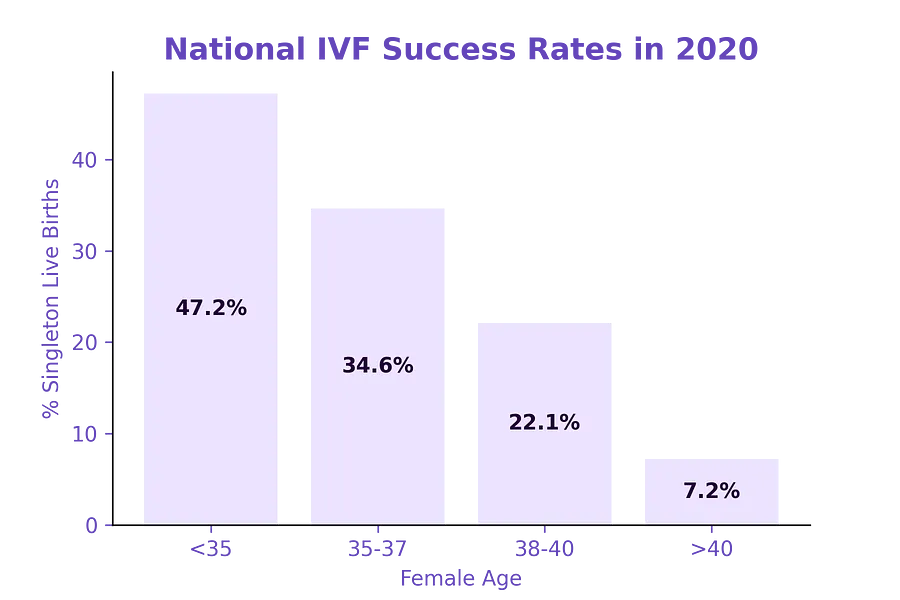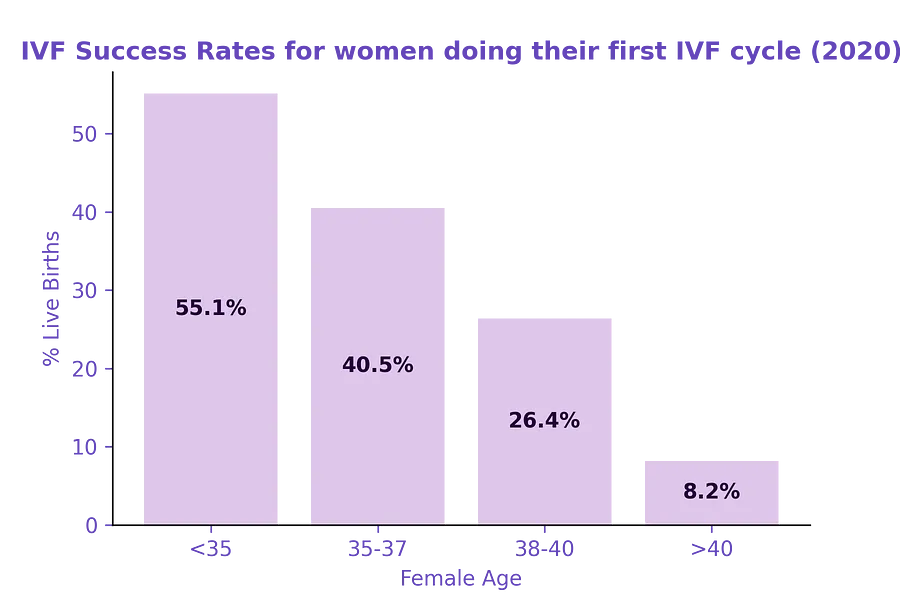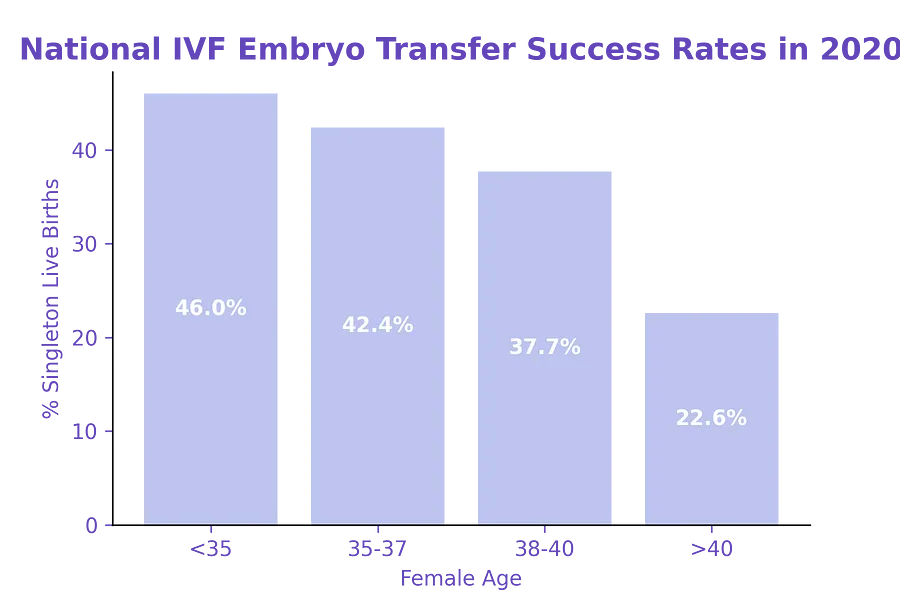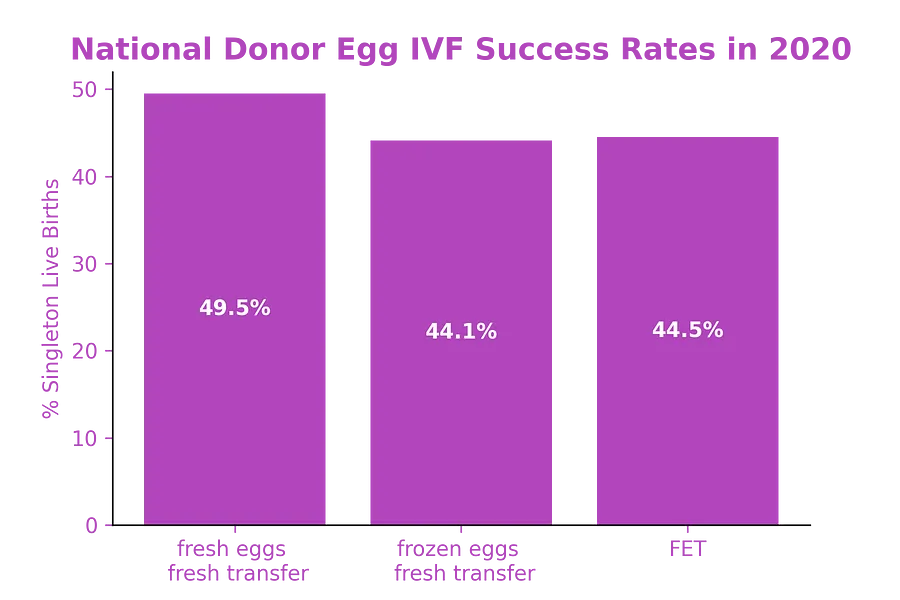Guides
Video
IVF Success Rates by Age in 2022 - United States Data
The newest data from the CDC has now been released for the year! The Centers for Disease Control (CDC) reports IVF success rates annually for hundreds of fertility clinics across the United States.
This information is made publicly available on the CDC’s website however, the format they provide the data in can be difficult to navigate and tricky to figure out which success rates you should actually be looking at.
The list success rates for a lot of different scenarios such as:
- Live births from all ‘intended’ retrievals
- Singleton live births from all ‘intended’ retrievals
- Live births from all retrievals
- Singleton live births from all retrievals
- Live births from all embryo transfers
- Singleton live births from transfers
- And even more!
Out of all these outcomes, which should you care about? 🤷♀️
Do you like your fertility clinic? 💌 🙏 Review your fertility doctoron our site! Other women need your opinion to help them choose a great fertility provider!
You should look at the Singleton Live Birth Rate for all indented retrievals and the Singleton Live Birth Rate from all embryo transfers.
The reason being, one baby born from a cycle is considered the optimal outcome for IVF. This is opposed to multiple gestations such as twins or triplets, in which there is an increased risk of health complications for both the mother and the baby.
This is why most clinics try to only ever transfer a single embryo during an IVF cycle, to try to optimize for the birth of one, healthy baby.
Still overwhelmed by all the metrics?
Luckily, we have put in the work for you to extract the data and make it more readable and easy to understand for the national averages and for each fertility clinic individually.
Looking for a specific fertility clinic’s IVF success rates? You can see the IVF success rates for an individual clinic by heading to our clinic search tool. 🕵️♀️
You can type in your city to see clinics in your area or enter the clinic’s name or a doctor’s name that you’re interested in.
The most up-to-date IVF success rates always lag by 2 years in reporting, so the 2022 ART (Assisted Reproductive Technology) report is for IVF cycles that occurred in 2020. This gives the CDC time to wait for birth outcomes from the IVF cycles and time for the clinic to report.
Let’s take a look at the averages to see what your chances of IVF success are based on your age range!
💌 🙏 Review your fertility doctor on our site! Takes less than 30 seconds but really helps other women who are getting started on their fertility journey! 💕
IVF Success Rates by Age
At this point, most women are aware that age affects one’s ability to get pregnant and even with the help of in vitro fertilization, the pregnancy and live birth rates decrease as women get older.
However, the outcomes are much better using IVF than naturally or with IUI and it’s possible for women in their late 30’s and early 40’s to conceive using their own eggs.
In this chart, we’re looking at all cycles for the year of 2020 for women using their own eggs for treatment, so these success rates don’t include donor eggs.
IVF success rates have increased slightly for each age group since the previous reporting year, which is very encouraging!
Now, for women less than 35 years old, 47.2% of IVF cycles resulted in the birth of a single baby, while for women over 40 using their own eggs, 7.2% of IVF cycles resulted in the live birth of a single baby.
These success rates include all cycles in 2020 where:
- women used their own eggs for IVF treatment
- a single baby was born from the pregnancy (doesn’t include success rates for twins, triplets, etc)
- all IVF cycles started (includes cycles cancelled partway due to poor medication response, no eggs retrieved, etc)
In cases where women are not able to get good quality embryos using their own eggs, they may opt to use donor eggs from a younger woman, as the better egg quality is more likely to lead to viable embryos. We’ll talk more about donor egg success rates later on.
We also used the success rates that include the small percentage of cycles that were cancelled after starting medications, sometimes due to a poor medication response or no eggs being retrieved. This gives a more realistic view of the success rates, it could be you that has to cancel, so better to factor that in when looking at the averages.
So, what about if you’re starting your first ever IVF cycle? What’s the chance that you’ll have a baby from your first ever IVF cycle?
First time doing IVF? Success rates for women undergoing their first ever IVF cycle
If you’re about to do your first ever IVF cycle, you might just want to know what the success rates are for women after doing their first ever IVF cycle.
Some women have to undergo multiple IVF cycles, lowering the success rates for the data overall.
You may have to do multiple cycles but to get an idea of what your first cycle would look like, here are the national averages that the CDC reported for new IVF patients starting their first cycle.
So now you can see that the success rates for the first IVF cycle are actually higher for all ages. This data included all live births that resulted from these IVF cycles, not just singleton births.
Women under 35 doing their first IVF cycle had a 55.1% success rate from ART treatment.
Women over 40 had a 8.2% success rate on their first IVF cycle.
If you’re considering moving on from IUI to doing IVF or if you haven’t done any previous treatment and your physician suggests IVF for you, these percentages can be really helpful in weighing your options and going into treatment with some idea of your chances for success.
Check out fertility clinics near you to see their success rates for your age.
We include their data for 1st time IVF patients at their clinic as well as the national averages so you can compare your options.
If you’ve already completed your egg retrieval and you’re wondering about success rates for the embryo transfer specifically, take a look at this next chart for the national averages.
IVF Success Rates by Clinic
Want to see what your chances of getting pregnant are with a specific fertility clinic?
While it's great to look at national average get a good idea of what your chances of getting pregnant with IVF are, the fertility clinic you choose can also impact your chances of success.
Check out our clinic directory to search fertility clinics across the United States and view IVF success rates by age for each fertility clinic.
Embryo Transfer Success Rates by Age
Here are the percent of embryo transfer cycles that resulted in the birth of a single baby.
This includes fresh embryo transfer cycles and frozen embryo transfer cycles.
Even for women that are older, late 30’s and early 40’s, the success rate when looking at an individual embryo transfer is fairly good.
So why don’t the IVF cycle data reflect that?
A lot of it is because women that are older usually 1) get less eggs and 2) of the eggs they do retrieve, they are less likely to result in a viable embryo to transfer.
So women that are older, even if they have embryos that develop, the embryos have a lower chance of being chromosomally normal than it is for younger women. Chromosomally abnormal embryos typically result in a negative pregnancy test after the transfer or a pregnancy loss.
Because of this, preimplantation genetic testing for aneuploidy or PGT-A (PGS) is becoming more popular in IVF cycles for older women using their own eggs.
In 2020, 46% of embryo transfers in women over 40 were of an embryo tested by PGT-A.
If women have their embryos tested by PGT-A before choosing an embryo to transfer, their physician can check to see whether an embryo has the correct number of chromosomes and would be able to lead to a healthy baby.
This way, women can avoid transferring an embryo that would result in a failed transfer cycle and improve their odds of having a successful embryo transfer cycle.
Considering paying to have your embryo tested by PGT-A?
Check out our article on the cost-effectiveness of PGT-A based on your age to see whether preimplantation genetic testing could save you money and time in treatment.
If you want to learn more about what PGT-A is and the success rates when using a PGT-A normal embryo for your age, check out Guide to PGT-A where we cover the most recent research.
Donor Egg IVF Success Rates
Ok, but what if you’re using donor eggs?
Some patients will need to go the route of egg donation in order to have a child. Although this route can be logistically difficult at times, it can provide some excellent success rates as the eggs are usually sourced from a young woman implying that her eggs will be able to generate viable embryos.
Of course, the sperm also has to be fair enough quality but usually when going the route of donor eggs, it’s to mitigate an issue with egg quality or because the patient in question doesn’t have any eggs of their own with which to use.
There are two typical routes people go when using an egg donor:
- donor undergoes an egg retrieval on your behalf (fresh eggs)
- purchase a cohort of frozen donor eggs
We’ll look at the donor egg IVF success rates for patients who used fresh donor eggs from a current retrieval, also known as a live donor IVF cycle and then we’ll also look at IVF success rates for couples using frozen donor eggs.
As age of the actual patient isn’t as big of a factor when utilizing donor eggs, the CDC reports the donor egg success rates for all ages as one metric.
Some patients worry about whether they should use fresh or frozen eggs but the success rates are acceptable for both. A live donor is also much more expensive, logistically more difficult, and can be hard to find
Unless you have someone who has already agreed to be your donor, you’d likely have to work with an agency and it could take time for them to source the donor and for all the paperwork to be complete.
So frozen donor eggs are a great option and can be shipped from egg banks in other parts of the country to your clinic.
Egg freezing Success Rates
The CDC doesn't provide very much information on success when it comes to fertility preservation, and that's primarily because there's still not a huge amount of data on success rates after using frozen eggs.
Egg freezing was considered experimental until 2012, so we are just coming up on 10 years of data for egg freezing.
If you want to know more about success rates of egg freezing, check out our article where we break down the latest research on egg freezing success so you can find out the best age to freeze your eggs and how many eggs you should aim to freeze to give you the best chances of a successful pregnancy in the future.
What else do you want to know about IVF outcomes?
Although this data from the CDC is very helpful, there’s often other sorts of stats that patients are looking for as well, which we typically find in the current clinical respect on infertility treatment.
Let us know if you have any questions surrounding IVF and we’ll dive into the data!
Not sure if IVF makes sense for you?
Check out our most recent article on when it makes sense to skip IUI and go straight to IVF.
Not sure if IVF makes sense for you?
Check out our most recent article on when it makes sense to skip IUI and go straight to IVF.
🕵️♀️ Ready to start looking for a fertility clinic? Find fertility clinics near you - view IVF success rates, read reviews, and compare fertility doctors.



